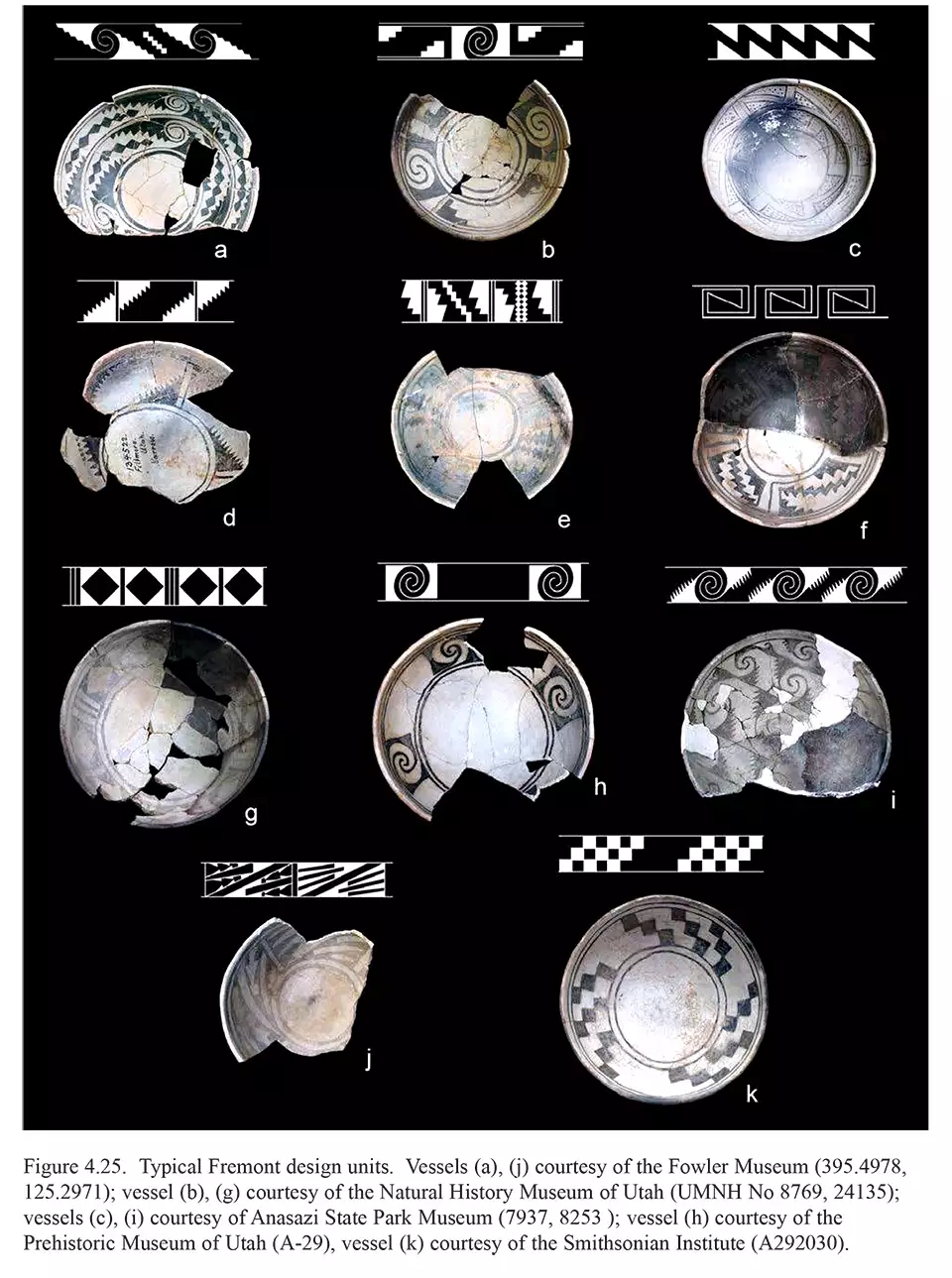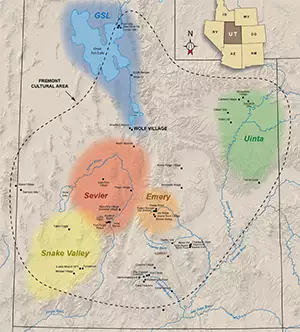Fremont Culture
The Fremont Culture is posited to have existed on the northern and northwestern frontier of the Ancestral Puebloans: north of the Virgin and Colorado Rivers across Utah to eastern Nevada, southern Idaho and northwestern Colorado. The name comes from a site discovered along the Fremont River in central Utah. It took years for enough archaeological research to be done to put together a semblance of their history and their migrations.
It seems early Utah (before 200 CE) was populated by widely dispersed groups of hunter-gatherers. That changed some time around 200 CE when a group of migrants from the south crossed the Colorado River from its east bank to its west bank and kept moving, looking for more hospitable countryside. Eventually they stumbled over some local folks and somehow merged in with them. That brought the first glimmers of agriculture, irrigation and the making of pottery to the region of the Great Basin. It also brought the first long-distance traders as those early Fremont stayed in touch with those who'd left the migration route earlier on. We don't know that they were looking for turquoise when they came north but they realized the value of it when they found it. And they shortly established trade routes leading south to central and southern Mexico. Along those trade routes, those traders sometimes encountered traders of Chacoan, Hohokam, Mogollon and other heritage.
One of the defining characteristics of the Ancestral Puebloan culture was the development and massive use of decorated pottery. Not so the Fremont. Only about five areas of central Utah in the Fremont zone produced any amount of pottery. Only two of those produced any significant amount of pottery, although their pottery was found throughout the Fremont Cultural Area (except in the Uinta Basin). As separated as those areas are by mountains and deserts, they also show evidence of regular social, technological and spiritual mixing and merging. The various Fremont areas did build above ground with stone and jacal architecture but they all oriented their structures differently from the Puebloans.
In essence, the Fremont Culture was more a complex of farming and foraging technologies and behaviors that adapted themselves to the day-to-day living conditions of the region as the people experienced them. However, the Southwest and the Great Basin areas are well known for their dryness and regular droughts, some that run for decades. The worse the weather gets, the further people are willing to migrate to find better conditions.
- 1783 CE : Laki in Iceland : lava and ash, caused several years of famine in the Northern Hemisphere, killed 80% of Iceland's livestock and 25% of the people starved to death
- 1600 CE : Huaynaputina in Peru : lava and ash, caused crop failures and famine across the Northern Hemisphere from 1601 into 1603
- 1452/1453 CE : Mystery eruption, possibly Kuwae in Vanuatu : several years of no sun, then flooding, then drought. It blew again in 1458, extending the disruptions
- 1315-1317 CE : Mount Tarawera in New Zealand : erupted ash and lava for 5 years, caused famine in Europe
- 1257 CE : Mount Samalas in Indonesia : lava and ash, triggered the Little Ice Age (may have triggered out-migration from Mesa Verde/Four Corners)
- (1060 CE : Sunset Crater eruption in Arizona : caused out-migration in northeastern Arizona)
- 946-950 CE : Paektu Mountain in China and Korea : global volcanic winter for several years
- 930 CE : Ceboruco in Nayarit, Mexico : ash and lava, afterwards active for 500 years
- 536 CE - Worst year in history to be alive anywhere on the planet
- 535 CE - Unknown source, possibly Krakatoa : ash and lava, no sun for months, then flooding, then drought
In 535 CE (Western calendar, of course) there was a massive volcanic eruption in Indonesia that made the global sky dark for several years. It was a volcanic winter for several years, then the floods started. A couple more years and the sun came back out but there was a prolonged drought. People all over the world suffered, populations plummeted, those who could moved to better geography. That brought more movement to northern Mexico and the Southwest. There is a horizon around 600 CE when a major step up in ceramic, agricultural and irrigation technology passed through the Hohokam region and into the Jornada Mogollon, Ancestral Puebloan and Fremont areas of influence.
In 930 CE, the Ceboruco volcano in Nayarit, Mexico blew its top, and remained active for about 500 years after. That may have been what started the mass migrations of the next 500 years. By then, San Juan Red Ware had been in full production in a zone of southeastern Utah along the Lower San Juan River for about 200 years. Many of the decorations on it are very similar to decorations found on black-on-gray Fremont pottery. That Red Ware has been found scattered widely across the Southwest but more concentrated in the Central and Eastern Mesa Verde regions. However, by the year 1000 CE, the population of the Lower San Juan River area crashed with mass migrations to the south and west.
There was a simultaneous increase in population in the Kayenta areas of northeastern Arizona. Pottery that has been recovered from those days has often been decorated with designs very much like those attributed to Fremont potters.
As adaptable as the people were to the constantly changing climate conditions of their geography, every semblance of cultural similarity among settlements in the larger Fremont area fell off dramatically in the 1300s CE, and were completely gone by about 1350. The people disappeared as a distinct people, leaving empty countryside behind for the Utes to occupy when they moved east from the Sierra Nevadas in the late 1300s.
A site was found in the environs of Canyonlands National Park (in the area of the Colorado Plateau Fremont) that had a cache of Kayenta decorated pottery hidden in it. That site may have been the northernmost influence and trading post of the Kayenta people. Nothing like it has been found in any other areas that archaeologists have assigned to the Fremont Culture.
The Fremont potters mostly made jars, bowls and pitchers. Only in two areas: Emery and Snake Valley, were decorations regularly painted on. There were significant variations in the designs, tempers and slips used by the potters in each locale, too. The most often painted design seems to have been of interlocking scrolls, both attached and unattached. They also liked two- and four-panel designs, upper and lower bounding bands and triangular or stepped designs in opposite corners of each panel. Rows of dots are another common Fremont design element. The potters saved their black paint for inside their bowls, hardly ever painting anything on the outside. Some jars were painted on the outside while some had a line around the opening on the inside. Most decorated pieces had black decorations on varying shades of grey and white. In the Great Salt Lake area local potters used a red paint to decorate their otherwise grey-and-white pottery. They also used that red paint in opposite manners to the way black paint was used. For instance, red paint was used on the outside of bowls and the design patterns were in opposition to those made in black. Speculation is that it was used to differentiate locally made wares from imported wares as the red paint wasn't found at any other locations.
Some archaeologists think some of the Fremont migrated southeast into the Lower San Juan and then Kayenta regions. Others went southwest and merged into the Virgin Branch Ancestral Puebloans and the incoming Utes and Paiutes. Still others migrated north, perhaps to Yellowstone, perhaps to the Big Horn Medicine Wheel. Whatever the path they took, they were soon headed east to the Black Hills where they merged with some Apache bands and became the Kiowa-Apache. They were shortly forced out of the Black Hills and by 1700 CE, most of them were in the Cuartelejo area north of the Arkansas River (in bison country). But by about 1350 CE, there were no more recognizable Fremont in Utah.
A modern potter from Jemez Pueblo decided he would research ancient Jemez shapes and decorations to see if he could recreate some of his people's pottery styles from the far past. His research followed the ceramic and ceremonial trail, guided by his knowledge of Jemez oral history. It led him to the canyons in southeast Utah, then across the Colorado River to the Fremont people. He felt his roots go back maybe as far as 200 CE.

Various Fremont design patterns
Many of the above designs are common to potters from Chaco, Kayenta, the Mimbres Valley, the Mogollon Rim and Paquimé. Some of them can be traced further back into prehistory as variations of more ancient rock art motifs. They are still common to modern Hopi, Zuni, Tewa, Towa and Keres potters.
Map and design pattern images courtesy of Katie K. Richards, part of a potential master's thesis submission at Brigham Young University, UT, 2014.